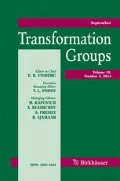Abstract
A GLd-pseudocharacter is a function from a group Γ to a ring k satisfying polynomial relations that make it “look like” the character of a representation. When k is an algebraically closed field of characteristic 0, Taylor proved that GLd-pseudocharacters of Γ are the same as degree-d characters of Γ with values in k, hence are in bijection with equivalence classes of semisimple representations Γ → GLd(k). Recently, V. Lafforgue generalized this result by showing that, for any connected reductive group H over an algebraically closed field k of characteristic 0 and for any group Γ, there exists an infinite collection of functions and relations which are naturally in bijection with H(k)-conjugacy classes of semisimple homomorphisms Γ→ H(k). In this paper, we reformulate Lafforgue's result in terms of a new algebraic object called an FFG algebra. We then define generating sets and generating relations for these objects and show that, for all H as above, the corresponding FFG-algebra is finitely presented up to radical. Hence one can always define H-pseudocharacters consisting of finitely many functions satisfying finitely many relations. Next, we use invariant theory to give explicit finite presentations up to radical of the FFG-algebras for (general) orthogonal groups, (general) symplectic groups, and special orthogonal groups. Finally, we use our pseudocharacters to answer questions about conjugacy vs. element-conjugacy of homomorphisms, following Larsen.
Similar content being viewed by others
References
H. Aslaksen, E.-C. Tan, C. Zhu, Invariant theory of special orthogonal groups, Pacific J. Math. 168 (1995), no. 2, 207–215.
T. Church, J. S. Ellenberg, B. Farb, FI-modules and stability for representations of symmetric groups, Duke Math. J. 164 (2015), no. 9, 1833–1910.
Y. Fang, G. Han, B. Sun, Conjugacy and element-conjugacy of homomorphisms of compact Lie groups, Pacific J. Math. 283 (2016), no. 1, 75–83.
G. Hochschild, Basic Theory of Algebraic Groups and Lie Algebras, Springer-Verlag, Berlin, 1981.
V. Lafforgue, Chtoucas pour les groupes réductifs et paramétrisation de Langlands globale, J. Amer. Math. Soc. 31 (2018), no. 3, 719–891.
M. Larsen, On the conjugacy of element-conjugate homomorphisms, Israel J. Math. 88 (1994), no. 1, 253–277.
M. Larsen, On the conjugacy of element-conjugate homomorphisms II, Quarterly J. Math. 47 (1996), no. 1, 73–85.
U. Nagel, T. Römer, FI- and OI-modules with varying coefficients, J. Algebra 535 (2019), 286–322.
V. L. Popov, E. B. Vinberg, Invariant Theory, in: Algebraic Geometry IV, Encyclopaedia of Mathematical Sciences, Vol. 55, Springer, Berlin, 1994, pp. 123–278.
C. Procesi, Lie Groups: An Approach through Invariants and Representations, Universitext, Springer-Verlag, New York, 2007.
C. Procesi, The invariant theory of n × n matrices, Advances in Math. 19 (1976), no. 3, 306–381.
R. W. Richardson, Affine coset spaces of reductive algebraic groups, Bull. London Math. Soc. 9 (1977), 38–41.
R. W. Richardson, Conjugacy classes of n-tuples in Lie algebras and algebraic groups, Duke Math. J. 57 (1988), no. 1, 1–35.
E. Rogora, A basic relation between invariants of matrices under the action of the special orthogonal group, Rend. Circ. Mat. Palermo 55 (2006), no. 1, 82–94.
G. W. Schwarz, On classical invariant theory and binary cubics, Ann. de l’Inst. Fourier 37 (1987), no. 3, 191–216.
R. Taylor, Galois representations associated to Siegel modular forms of low weight, Duke Math. J. 63 (1991), no. 2, 281–332.
E. B. Vinberg, On invariants of a set of matrices, J. Lie Theory 6 (1996), 249–269.
A. Wiles, On ordinary ⋋-adic representations associated to modular forms, Invent. Math. 94 (1988), no. 3, 529–573.
J. Yu, Acceptable compact Lie groups, arXiv:1806.06316 (2018).
J. Yu, Invariants and pseudo-characters, Private communication, August 2019.
Author information
Authors and Affiliations
Corresponding author
Additional information
Publisher’s Note
Springer Nature remains neutral with regard to jurisdictional claims in published maps and institutional affiliations.
M. WEIDNER is partially supported by Caltech’s Samuel P. and Frances Krown SURF Fellowship and a Churchill Scholarship from the Winston Churchill Foundation of the USA.
Rights and permissions
About this article
Cite this article
WEIDNER, M. PSEUDOCHARACTERS OF HOMOMORPHISMS INTO CLASSICAL GROUPS. Transformation Groups 25, 1345–1370 (2020). https://doi.org/10.1007/s00031-020-09603-2
Received:
Accepted:
Published:
Issue Date:
DOI: https://doi.org/10.1007/s00031-020-09603-2


